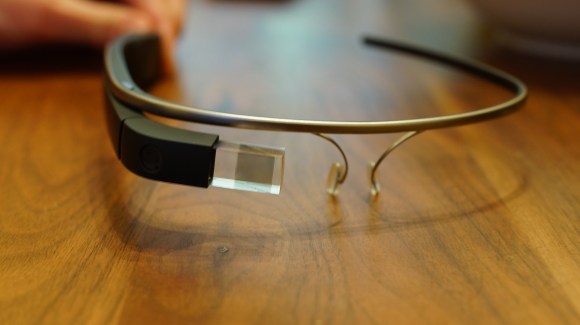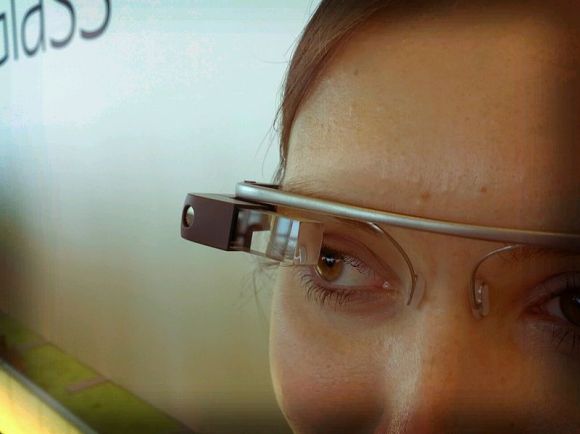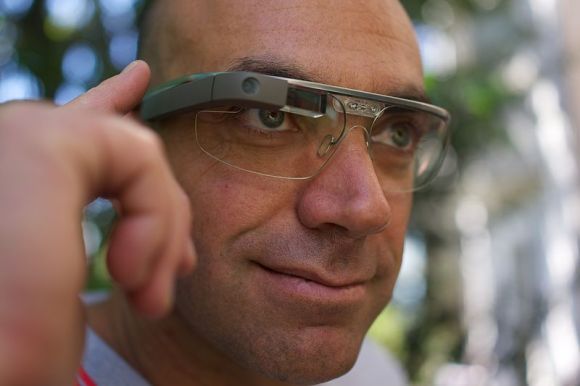
By now, you’ve surely heard about Google Glass, the head-mounted computer that allows the wearer to interact with data while going about their day thanks to a tiny display that hovers in the top-right corner of their vision. While this all sounds like a wonderful little slice of the future, the product has come under scrutiny recently amid privacy concerns raised by politicians, and many are wondering about the possible implications of using it in the real world.
While most reviews have been from the perspective of native English-speakers, today we stumbled upon an interesting review written by a Japanese speaker. Despite the country being considered by many to be the home of computer wizardry, Japanese people are often a little shy of new devices at first (the iPhone was positively ignored for its first year on the market), so we were keen to get a Japanese perspective.
Just a couple of paragraphs into the writeup, however, we noticed that the reviewer had stumbled upon a couple of minor problems with Google Glass.
Written by Tazunu Ishikawa for Weekly ASCII, the review starts with the basic Google Glass run down. You can connect Glass to the Internet via a smartphone or wi-fi; it’s got a touch panel on the side to control Glass with; it uses both voice commands and motion detection to navigate the interface, take photos, do searches, and respond to text messages. It all sounds great. But it was when trying to communicate with the device that Ishikawa had trouble.
▼A logo so simple, it can’t even be copyrighted, according to Wikipedia.
Since Google Glass is still in development (only 2,000 units have been shipped so far and all of them to app/software developers), it’s pretty much English only. As others have documented, there are certain English words that can be difficult for non-native speakers to pronounce. That said, voice recognition software doesn’t always correctly understand native speakers, so this isn’t just an issue for Japanese people.
Ishikawa pointed out another potential problem with Glass—they don’t fit well over real glasses. So, if you happen to need prescription spectacles, you’ll probably want to grab some contacts to use with the device. However, the reporter did mention that the screen was easy to see and had good definition, so at least your contacts will be worth the investment!
▼Nerd fashion is fashion!
In addition to taking pictures and recording videos (with consent only, please!!!), Glass is great for directions. If you can get the device to understand where you want to go. Ishikawa noted that he had some trouble getting the software to understand exactly what he was looking for. Finally, he settled on that old stand-by “Starbucks.” This really seems like a commercial waiting to be made, doesn’t it?
Another issue with language support came from social networks. Ishikawa notes that when attempting to display tweets in Japanese, Glass just threw up a bunch of question marks, suggesting that language packs have yet to be added. At least the basic functionality is there, right?
▼The most heroic-looking smartphone peripheral ever? We think so!
Overall, Weekly ASCII‘s reviewer seemed impressed with Glass. And, since it can interface with both Android phones and iPhones, searches can be culled and categorized to improve your advertising experience regardless of the smartphone you use.
We’re sure that Google will add better language support once they get closer to full production. So we can’t wait to see the results of Ishikawa vs Google’s voice recognition round two!
Source: Weekly ASCII
Images: Wikipedia




 Best instruction manual ever? What to do when your washer goes “kiiin”, “shaaa”, or “pokopoko”
Best instruction manual ever? What to do when your washer goes “kiiin”, “shaaa”, or “pokopoko” Worst vacation ever? DMM to offer a week of hikikomori life free to one lucky fan
Worst vacation ever? DMM to offer a week of hikikomori life free to one lucky fan First gorillas, now horses – Google Photos app really needs to get its act together
First gorillas, now horses – Google Photos app really needs to get its act together What happens when you combine two of the scariest movies ever? You get Sadako vs Kayako!
What happens when you combine two of the scariest movies ever? You get Sadako vs Kayako! Best random JRPG encounter ever? When giant 3-D Dragon Quest Slimes appear in Tokyo!【Video】
Best random JRPG encounter ever? When giant 3-D Dragon Quest Slimes appear in Tokyo!【Video】 Disney princesses get official manga makeovers for Manga Princess Cafe opening in Tokyo
Disney princesses get official manga makeovers for Manga Princess Cafe opening in Tokyo Randomly running into a great sushi lunch like this is one of the best things about eating in Tokyo
Randomly running into a great sushi lunch like this is one of the best things about eating in Tokyo Beautiful new Final Fantasy T-shirt collection on the way from Uniqlo【Photos】
Beautiful new Final Fantasy T-shirt collection on the way from Uniqlo【Photos】 Foreign English teachers in Japan pick their favorite Japanese-language phrases【Survey】
Foreign English teachers in Japan pick their favorite Japanese-language phrases【Survey】 Is the new Shinkansen Train Desk ticket worth it?
Is the new Shinkansen Train Desk ticket worth it? Kyushu-exclusive Black Mont Blanc goes nationwide in a “Special” way
Kyushu-exclusive Black Mont Blanc goes nationwide in a “Special” way Hey, Japanese taxi driver! Take us to your favorite restaurant in Tsuruga City!
Hey, Japanese taxi driver! Take us to your favorite restaurant in Tsuruga City! Daiso opens massive new 25,392-square foot Tokyo flagship store with its two sub-brands included
Daiso opens massive new 25,392-square foot Tokyo flagship store with its two sub-brands included Masahiko Ozumi Paris in Osaka makes the comfiest desserts around
Masahiko Ozumi Paris in Osaka makes the comfiest desserts around U.K. coffee brand Costa Coffee releases first ever matcha flavor with new Matcha Espresso Latte
U.K. coffee brand Costa Coffee releases first ever matcha flavor with new Matcha Espresso Latte Our Japanese reporter visits Costco in the U.S., finds super American and very Japanese things
Our Japanese reporter visits Costco in the U.S., finds super American and very Japanese things New Studio Ghibli bedding sets are cool in all senses of the word
New Studio Ghibli bedding sets are cool in all senses of the word We try out “Chan Ramen”, an underground type of ramen popular in the ramen community
We try out “Chan Ramen”, an underground type of ramen popular in the ramen community New Pokémon cakes let you eat your way through Pikachu and all the Eevee evolutions
New Pokémon cakes let you eat your way through Pikachu and all the Eevee evolutions There’s a park inside Japan where you can also see Japan inside the park
There’s a park inside Japan where you can also see Japan inside the park Japanese black curry “experiment” takes place at an unlikely restaurant branch in Tokyo
Japanese black curry “experiment” takes place at an unlikely restaurant branch in Tokyo Japanese convenience store packs a whole bento into an onigiri rice ball
Japanese convenience store packs a whole bento into an onigiri rice ball New definition of “Japanese whiskey” goes into effect to prevent fakes from fooling overseas buyers
New definition of “Japanese whiskey” goes into effect to prevent fakes from fooling overseas buyers Uniqlo opens its first Furugi Project secondhand clothing pop-up shop in Tokyo
Uniqlo opens its first Furugi Project secondhand clothing pop-up shop in Tokyo Studio Ghibli releases Kiki’s Delivery Service chocolate cake pouches in Japan
Studio Ghibli releases Kiki’s Delivery Service chocolate cake pouches in Japan Japan’s bone-breaking and record-breaking roller coaster is permanently shutting down
Japan’s bone-breaking and record-breaking roller coaster is permanently shutting down Toyota built a life-sized Miraidon Pokémon and are letting people test drive it this weekend
Toyota built a life-sized Miraidon Pokémon and are letting people test drive it this weekend Foreign passenger shoves conductor on one of the last full runs for Japan’s Thunderbird train
Foreign passenger shoves conductor on one of the last full runs for Japan’s Thunderbird train Kyoto bans tourists from geisha alleys in Gion, with fines for those who don’t follow rules
Kyoto bans tourists from geisha alleys in Gion, with fines for those who don’t follow rules Studio Ghibli unveils Mother’s Day gift set that captures the love in My Neighbour Totoro
Studio Ghibli unveils Mother’s Day gift set that captures the love in My Neighbour Totoro Domino’s Japan now sells…pizza ears?
Domino’s Japan now sells…pizza ears? New Japanese KitKat flavour stars Sanrio characters, including Hello Kitty
New Japanese KitKat flavour stars Sanrio characters, including Hello Kitty Sales of Japan’s most convenient train ticket/shopping payment cards suspended indefinitely
Sales of Japan’s most convenient train ticket/shopping payment cards suspended indefinitely Sold-out Studio Ghibli desktop humidifiers are back so Totoro can help you through the dry season
Sold-out Studio Ghibli desktop humidifiers are back so Totoro can help you through the dry season Japanese government to make first change to romanization spelling rules since the 1950s
Japanese government to make first change to romanization spelling rules since the 1950s Ghibli founders Toshio Suzuki and Hayao Miyazaki contribute to Japanese whisky Totoro label design
Ghibli founders Toshio Suzuki and Hayao Miyazaki contribute to Japanese whisky Totoro label design Doraemon found buried at sea as scene from 1993 anime becomes real life【Photos】
Doraemon found buried at sea as scene from 1993 anime becomes real life【Photos】 Tokyo’s most famous Starbucks is closed
Tokyo’s most famous Starbucks is closed One Piece characters’ nationalities revealed, but fans have mixed opinions
One Piece characters’ nationalities revealed, but fans have mixed opinions We asked a Uniqlo employee what four things we should buy and their suggestions didn’t disappoint
We asked a Uniqlo employee what four things we should buy and their suggestions didn’t disappoint Princesses, fruits, and blacksmiths: Study reveals the 30 most unusual family names in Japan
Princesses, fruits, and blacksmiths: Study reveals the 30 most unusual family names in Japan Studio Ghibli’s new desktop Howl’s Moving Castle will take your stationery on an adventure
Studio Ghibli’s new desktop Howl’s Moving Castle will take your stationery on an adventure People are really excited about that ‘Doraemon-like’ translating megaphone
People are really excited about that ‘Doraemon-like’ translating megaphone Weirdest collaboration ever? Convenience store + menstruation website = pink bread
Weirdest collaboration ever? Convenience store + menstruation website = pink bread Japanese gamers anxious to get hands on South Korea’s latest hit: Destiny Child 【Pics, Videos】
Japanese gamers anxious to get hands on South Korea’s latest hit: Destiny Child 【Pics, Videos】 Japan’s postal service: So great it’ll even deliver a single leaf to your home
Japan’s postal service: So great it’ll even deliver a single leaf to your home Worst birthday present ever? Japanese brother’s gift puzzle leads to a “fabulous” prize
Worst birthday present ever? Japanese brother’s gift puzzle leads to a “fabulous” prize Best field trip ever? Japanese schoolkids get to control the full-scale moving Gundam’s hand
Best field trip ever? Japanese schoolkids get to control the full-scale moving Gundam’s hand Affordable glasses that help blind people understand text now receiving crowdfunding support
Affordable glasses that help blind people understand text now receiving crowdfunding support Which parts of Ishikawa are OK to travel to after Noto quake? Government shares guideline map
Which parts of Ishikawa are OK to travel to after Noto quake? Government shares guideline map Most Japanese theft ever? Chainsaws taken to flowering cherry blossoms in Osaka
Most Japanese theft ever? Chainsaws taken to flowering cherry blossoms in Osaka Google Japan unveils tea-cup shaped keyboard with open-source all-fish input system
Google Japan unveils tea-cup shaped keyboard with open-source all-fish input system Tonight vs Hotel Tonight – Did GREE just rip off one of America’s most popular hotel apps?
Tonight vs Hotel Tonight – Did GREE just rip off one of America’s most popular hotel apps? Google Japan creates the Key Bou, an insane and logical straight-bar keyboard【Video】
Google Japan creates the Key Bou, an insane and logical straight-bar keyboard【Video】 Google kicks off April Fools’ Day with a Google Maps Pokemon Challenge that’s actually real…kinda
Google kicks off April Fools’ Day with a Google Maps Pokemon Challenge that’s actually real…kinda Japanese Twitter users make Osaka Metro’s English translation mistakes into running joke, memes
Japanese Twitter users make Osaka Metro’s English translation mistakes into running joke, memes REVIEW: Samsung’s new fitness gadget makes a sleek smartwatch
REVIEW: Samsung’s new fitness gadget makes a sleek smartwatch
Leave a Reply